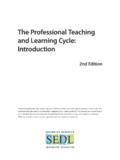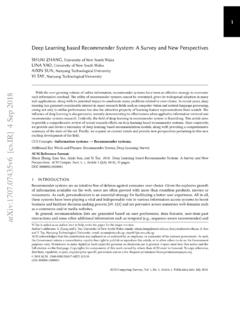Transcription of Work-Integrated Learning: Good Practice Guide - che.ac.za
1 Council on Higher Education Work-Integrated learning : Good Practice Guide HE Monitor August 2011. Work-Integrated learning : Good Practice Guide HE Monitor No. 12. A u g u s t 2 0 11. The CHE is an independent statutory body established by the Higher Education Act, no. 101 of 1997. The CHE is the Quality Council for Higher Education, advises the Minister of Education and Training on all higher education issues and is responsible for quality assurance and promotion through the Higher Education Quality Committee. Published by the Council on Higher Education (CHE) in 2011. 1 Quintin Brand Street Persequor Technopark Brummeria Pretoria South Africa +27 12 349 3840. Produced on behalf of the CHE by IeCommunications Toscana, IL Villagio, 5 de Havilland Crescent Persequor Park Brummeria Pretoria +27 12 349 2811. Council on Higher Education, Pretoria, 2011. All rights reserved. Material from this publication may not be reproduced without the CHE's permission.
2 ISBN 978-1-919856-81-0. TABLE OF CONTENTS. Pages FOREWORD 1. ACKNOWLEDGEMENTS 2. 1 INTRODUCTION AND BACKGROUND 3. Purpose and overview of the Guide 3. Who is this Guide for? 4. Defining Work-Integrated learning 4. Work-Integrated student learning 6. Work-Integrated learning in South African higher education 6. Early understandings and approaches to Work-Integrated learning 7. Challenges to traditional practices 7. 2 A CONCEPTUAL FRAMEWORK FOR Work-Integrated learning 8. Science, higher education and professional Practice : three interrelated fields 8. Professional education: looking both ways 9. Crossing knowledge boundaries 10. Recontextualising academic knowledge in the world of work 10. Recontextualising workplace knowledge in the academic curriculum 11. learning in and across the different knowledge fields 11. 3 CURRICULUM DESIGN AND DEVELOPMENT FOR Work-Integrated learning 13. Introduction to curriculum 13.
3 Curriculum development in Work-Integrated learning 13. Curriculum planning 14. Curricular modalities 16. work -directed theoretical learning 16. Problem-based learning 17. Project-based learning 18. Workplace learning 19. A Work-Integrated learning typology 21. Implications for Work-Integrated learning at different HEQF levels 22. Work-Integrated learning in a 1-year certificate (HEQF Level 5) 23. Work-Integrated learning in a 2-year advanced certificate (HEQF Level 6) 23. Work-Integrated learning in a 3-year diploma/Bachelor's degree (HEQF Level 7) 24. Work-Integrated learning in a 4-year professional Bachelor's degree (HEQF Level 8) 24. Work-Integrated learning in a Master's degree (HEQF level 9) 25. Work-Integrated learning in a Doctoral degree (HEQF level 10) 26. The formal accreditation of Work-Integrated learning 27. The accreditation of work -directed theoretical learning 27. The accreditation of problem-based learning 27.
4 The accreditation of project-based learning 27. The accreditation of workplace learning 27. Recognition of prior learning in a Work-Integrated learning curriculum 29. 4 TEACHING AND learning Work-Integrated learning 31. Teaching for transfer 31. Student learning in Work-Integrated learning 32. Academic and workplace collaboration in teaching and learning 32. Pedagogical approaches for different WIL curricular modalities 32. work -directed theoretical learning 32. Problem-based learning 33. Project-based learning 36. Workplace learning 37. 5 ASSESSMENT OF/FOR Work-Integrated learning 41. Principles of Work-Integrated learning 41. Formative assessment for Work-Integrated learning 42. Summative assessment of Work-Integrated learning 43. Developing assessment tasks 44. Demonstrating knowledge and understanding 44. Thinking critically and making judgements 44. Solving problems 44. Performing procedures and demonstrating techniques 45.
5 Designing, creating and performing 45. Managing and developing oneself 45. Accessing and managing information 45. Assessment criteria for Work-Integrated learning 45. Assessment for Work-Integrated learning curricular modalities 46. work -directed theoretical learning 46. Problem-based learning 47. Project-based learning 48. Workplace learning 48. 6 PARTNERSHIPS FOR Work-Integrated learning 51. Introduction to partnerships for Work-Integrated learning 51. Partnerships for the different Work-Integrated learning curricular modalities 51. Partnerships for work -directed theoretical learning 51. Partnerships for problem-based learning 52. Partnerships for project-based learning 54. Partnerships for workplace learning 55. Managing partnerships 56. Initiating partnerships 56. Implementing partnerships 57. Maintaining partnerships 57. Reflection and evaluation 57. 7 MANAGING Work-Integrated learning 58.
6 Introduction to the management of Work-Integrated learning 58. Managing Work-Integrated learning : the institutional level 58. Managing Work-Integrated learning : the departmental level 60. work -directed theoretical learning 60. Problem-based learning 60. Project-based learning 61. Workplace learning 62. Managing resources for Work-Integrated learning 63. Financial resources 63. Staff resources 64. Physical resources 64. 8 CONCLUSION 65. BIBLIOGRAPHY 66. GLOSSARY OF TERMS 71. FOREWORD. The Higher Education Quality Committee (HEQC) in 2002, in the context of developing the national quality assurance system, established a project to foreground the core function of teaching and learning in the context of the restructuring of higher education. Subsequently it published the Improving Teaching and learning Resource (March 2005) as part of its prioritisation of quality issues in teaching and learning .
7 Since then, there have been a number of teaching and learning related publications that have served to increase the level of national and institutional debates on the conceptualisation, quality and Practice of teaching and learning . Examples of such publications include, Service- learning in the Curriculum: A Resource for Higher Education Institutions (2006), A Good Practice Guide and Self-evaluation Instruments for Managing the Quality of Service- learning (2006), Higher Education Monitor: A Case for Improving Teaching and learning in South African Higher Education (2007), Case studies on dealing with pipeline students within their respective institutions (2007), Service- learning in the Disciplines: Lessons from the Field (2008), and Higher Education Monitor: Access and Throughput in South African Higher Education - Three case studies (2010). A central feature of the HEQC's approach since its inception has been to initiate and facilitate quality-related capacity development activities in a collaborative manner across a range of areas in higher education, including the Practice of teaching and learning .
8 The quality promotion and capacity development activities for the South African higher education sector have included the conducting of large dedicated projects in selected areas, workshops, training sessions, seminars, and publications. This publication, Work-Integrated learning : A Guide for Higher Education Institutions, is intended to assist those involved in programme development and in the curriculum development and adaptation required by the Higher Education Qualifications Framework (October 2007). It also aims to prompt other academics who are involved in teaching to consider the educational purpose and role of Work-Integrated learning in teaching and learning . As the authors argue, University teachers should be concerned to ensure that the students that graduate from their programmes are prepared for the world in which they will live and work . The publication provides a theoretical foundation for Work-Integrated learning while making use of a large number of local and international case studies for illustration and example.
9 The authors, contributors and reviewers are thanked for producing this publication within a short time-frame. The comprehensiveness of its content and the care taken by the authors to make the topics accessible to the reader is greatly appreciated. A word of appreciation is extended to Ms Bella Sattar who initially took charge of the project, and to Professor Chris Winberg who subsequently coordinated the writing of the manuscript to its completion. The Programmes and Qualifications Committee of the South African Technology Network is thanked for the initial idea to produce this publication. The CHE hereby expresses its gratitude to Professor Anthony Staak, of the South African Technology Network, for overseeing the submission of the draft document. Dr Mark Hay Executive Director August 2011. Work-Integrated learning : Good Practice Guide 1. ACKNOWLEDGEMENTS. Authors: Professor Christine Winberg (co-ordinator), Associate Professor Penelope Engel-Hills, Dr James Garraway and Associate Professor Cecila Jacobs (Cape Peninsula University of Technology).
10 Contributors: Ms Marianne Bester (Cape Peninsula University of Technology), Mr Riaan Bouwer (Central University of Technology), Professor Ansu Erasmus (Tshwane University of Technology), Mr Alpheus Maphosa (Vaal University of Technology), Dr Joyce Nduna (Cape Peninsula University of Technology), Ms Fundiswa Nofemala (Cape Peninsula University of Technology), Mr Julian Vooght (Durban University of Technology) and Dr Marius Wessels (Tshwane University of Technology). Reviewers: Dr Jeanne Gamble (University of Cape Town) and Dr Matete Madiba (University of Pretoria). 2 Work-Integrated learning : Good Practice Guide CHAPTER ONE. Introduction and Background Purpose and overview of the Guide There is considerable interest, both in South Africa and internationally, in curricular and pedagogical reform that will both support students from diverse backgrounds and prepare them for the challenges of the global economy and responsible citizenship.


















